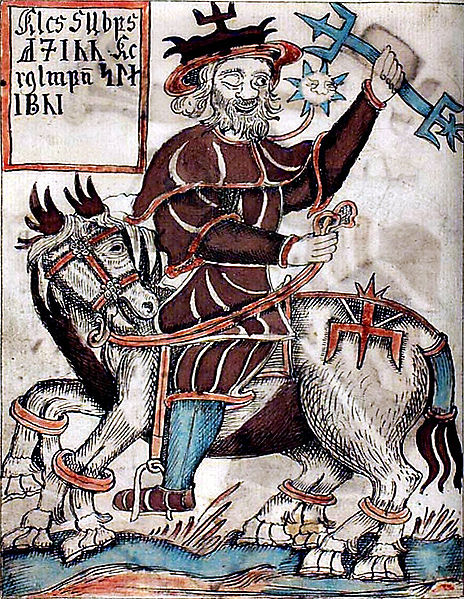Aser Yule-time:

 THE OLD YULE-TREE DECORATIONS IN FINLAND
THE OLD YULE-TREE DECORATIONS IN FINLAND - The tree itself, spruce, grows from the light and warmth of Sun, then falls and turns to earth, in which we humans can grow food, holy tree, taken inside at 24th of Yule-month to be decorated.
- The seven-pointed golden star on top, as Sun, or Ukko Väinämöinen, as the father of all people, golden stripes coming down as the rays of sun, or as his semen, to cultivate beautiful people.
- A string with flags of many nations, to show the people Ukko has fathered
- Seven live candles on branches, as the seven stars of Little Bear, of which one is the North Star, on top of North Pole, believed to be on one island in front of Helsinki.
- Silvery paper-stripes hanging from branches, as the rays of Moon, reflecting wisdom from Ukko´s first son, the King, Seppo Ilmarinen, still seen as a **** on our vocabulary.
- Apples hanging from branches, as reminders of fertility, Adam´s "that" apple!
- Spark throwing sticks on branches, reminders of the ancient swastika, built from sulphur-filled straws, pivoted from middle, on stand, lighted, turning around, and as you look from one side, turning clockwise, showing how the semen of Pukki (Bock) Lemminkäinen, was spread to all people, looking from the other side, anti-clockwise, show wisdom spreading from the King.
- Real cookies, in forms of Yule tree, Sun, quarter Moon, man and woman, Yule-Bock, heart, and happiness-bringing four leaf clover were hanged from the branches
- Ten Robins, as the son’s Father, the brotherhood, suppliers of Nectar.
- Six Angels, the daughters of Him, who created the stories for children.
Yule-time started at 13th of Yule-month, at Lucia-day, ended at13th of Oak-month. (January)
On 24th the Father, (Ukko) the King and the Yule-Bock, the three wise men came in to give gifts to the new-born new King (once in every lifetime) who had been seeded at Easter, by the Pukki Lemminkäinen, the seeder, the next Ukko, from which name came the letters OK
At Boxing-day, two young men with pouches filled with sand, sat on
a log, lifted on two bocks, facing each other, trying to hit each other
to fall down, as part of the test of manhood, besides having to dance the strenuous cossack dance. Girls danced naked at the Labyrinth, to show their beauty, feminism and ability for easy delivery, as only beautiful and healthy people were allowed to have children then, and these young passed maidens were allowed to select the man they liked most, from a row of naked, manly and good-looking athletes, as it was most important for the girl to be in love because only then can the child be beautiful and healthy.
Leo Nygren Häll,sing-e MMVII
leo.nygren@kolumbus.fiFrom Wiki:
Lucia, Feast of St. Lucy (Ancient Swedish, Scandinavian Lutheran, Eastern Orthodox)
Lucia or Lussi Night happened on December 13, what was supposed to be the longest night of the year. The feast was later appropriated by the Catholic Church in the 16th century as St. Lucy's Day. It was believed in the folklore of Sweden that if people, particularly children, did not carry out their chores, the female demon, the Lussi or Lucia die dunkle would come to punish them.[19]
Also from Wiki:
Midvinterblót (Swedish folk religion)
In Sweden and many surrounding parts of Europe, polytheistic tribes celebrated a Midvinterblot or mid-winter-sacrifice, featuring both animal and human sacrifice. The blot was performed by goši, or priests, at certain cult sites, most of which have churches built upon them now. Midvinterblot paid tribute to the local gods, appealing to them to let go winter's grip. The folk tradition was finally abandoned by 1200 CE, due to missionary persistence.

Also from Wiki:
Sol Invictus Festival (3rd century Roman Empire)
Sol Invictus ("the undefeated Sun") or, more fully, Deus Sol Invictus ("the undefeated sun god") was a religious title applied to at least three distinct divinities during the later Roman Empire; El Gabal, Mithras, and Sol. A festival of the birth of the Unconquered Sun (or Dies Natalis Solis Invicti) was celebrated when the duration of daylight first begins to increase after the winter solstice, — the "rebirth" of the sun. The Sol Invictus festival ran from December 22 through December 25, which at that time was at the solstice. With the growing popularity of the Christian cults, Jesus of Nazareth came to adopt much of the recognition previously given to a sun god, there by, including Christ into the tradition. This was later condemned by the early Catholic Church for its pagan practices and for associating the Christ with the other sun gods.
More from Wiki:
Yule, Jul, Jól, Joul, Joulu, Jõulud, Géol, Geul (Viking Age, Northern Europe)
Icelandic manuscript depicting Odin who slayed the frost giant, Ymir.Main article: Yule
Originally the name Giuli signified a 60 day tide beginning at the lunar midwinter of the late Scandinavian Norse and Germanic tribes. The arrival of Juletid thus came to refer to the midwinter celebrations. By the late Viking Age, the Yule celebrations came to specify a great solstitial Midwinter festival that amalgamated the traditions of various midwinter celebrations across Europe, like Mitwinternacht, Modrasnach, Midvinterblot, and the Teutonic solstice celebration, Feast of the Dead. A documented example of this is in 960, when King Håkon of Norway signed into law that Jul was to be celebrated December 25, to align it with the Christian celebrations. For some Norse sects, Yule logs were lit to honor Thor, the god of thunder. Feasting would continue until the log burned out, three or as many as twelve days. The indigenous lore of the Icelandic Jól continued beyond the Middle Ages, but was condemned when the Reformation arrived. The celebration continues today throughout Northern Europe and elsewhere in name and traditions, for Christians as representative of the nativity of Jesus, and for others as a cultural winter celebration.
